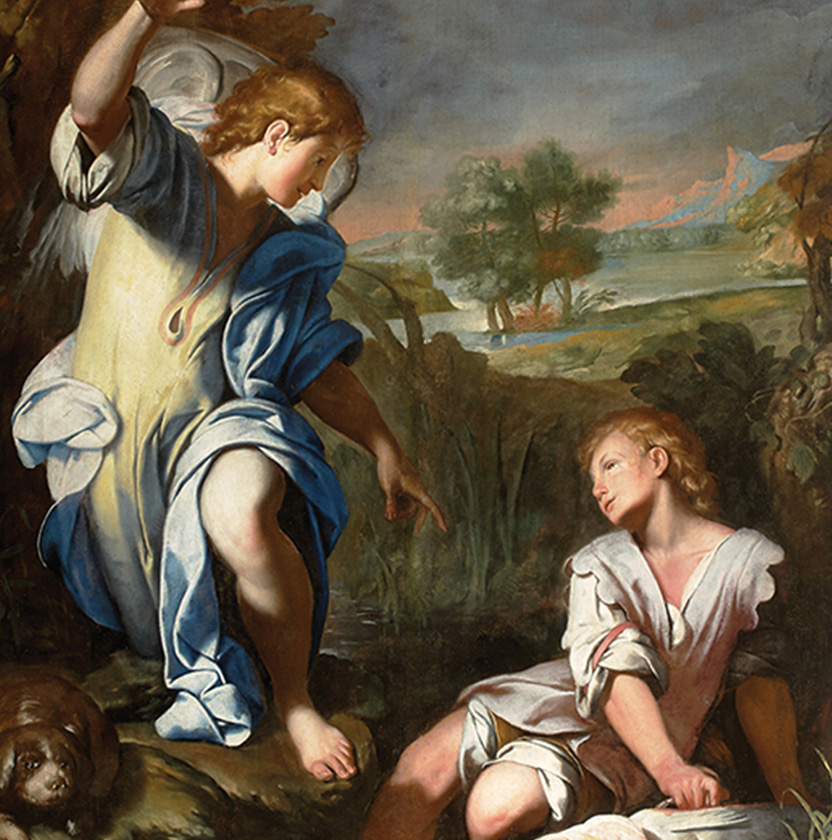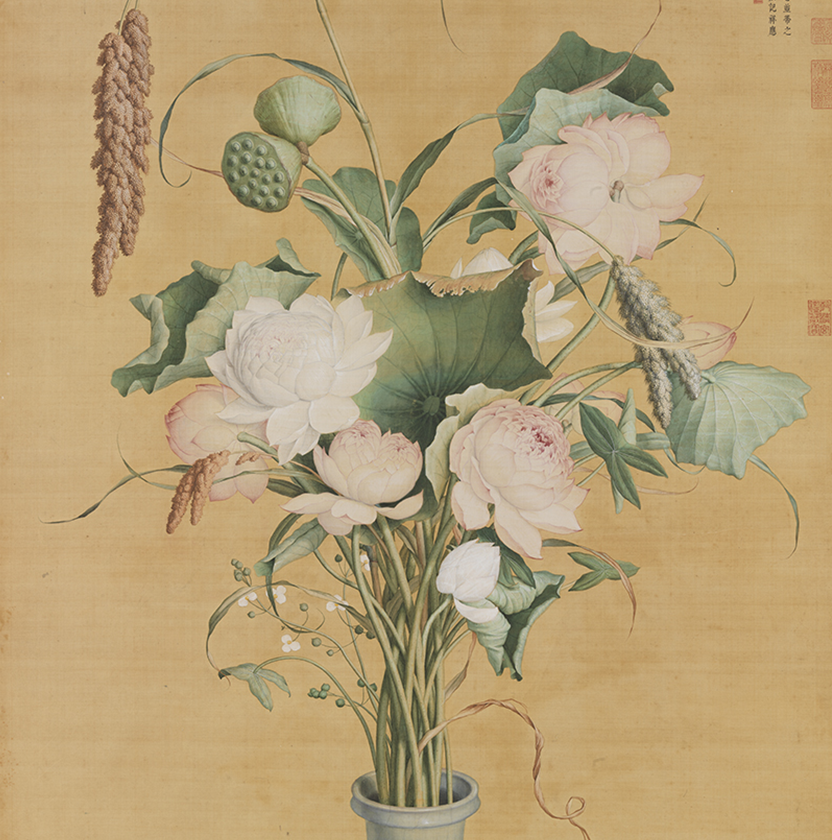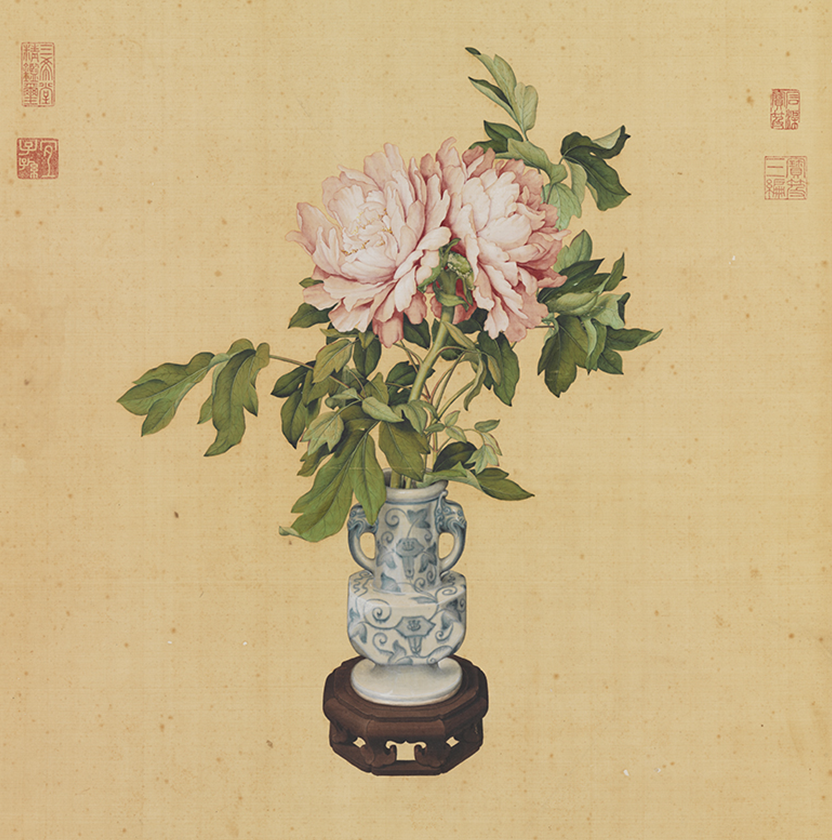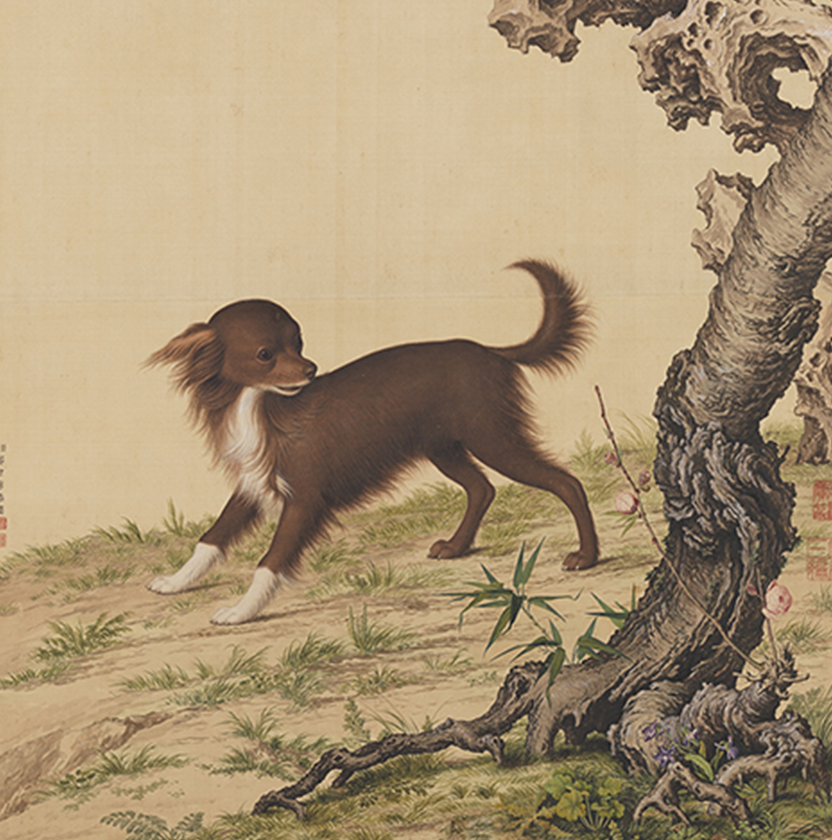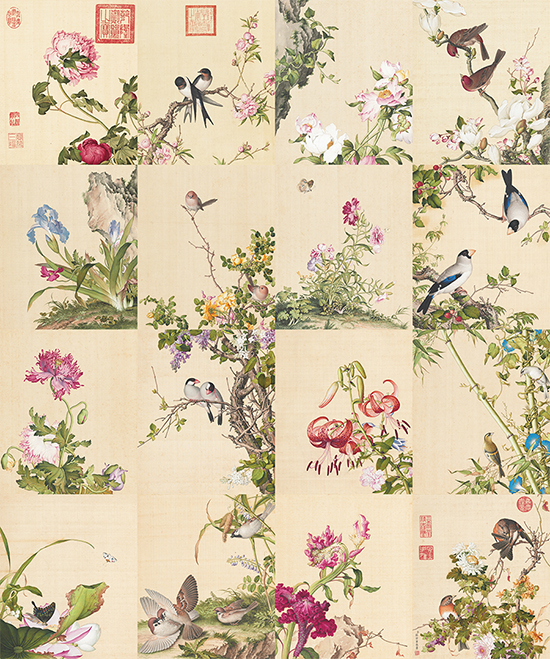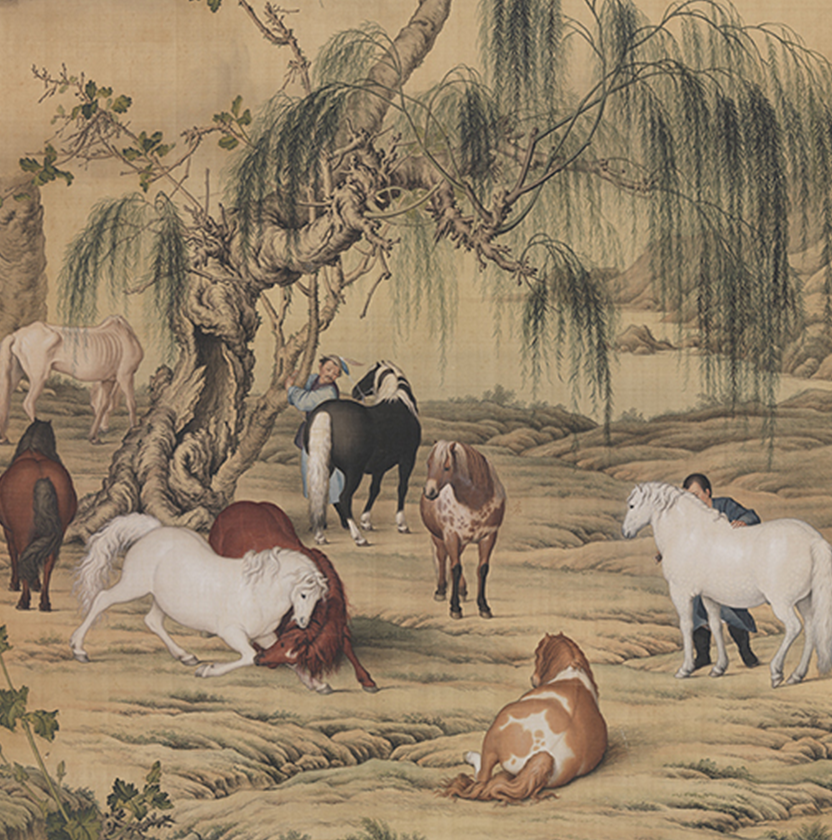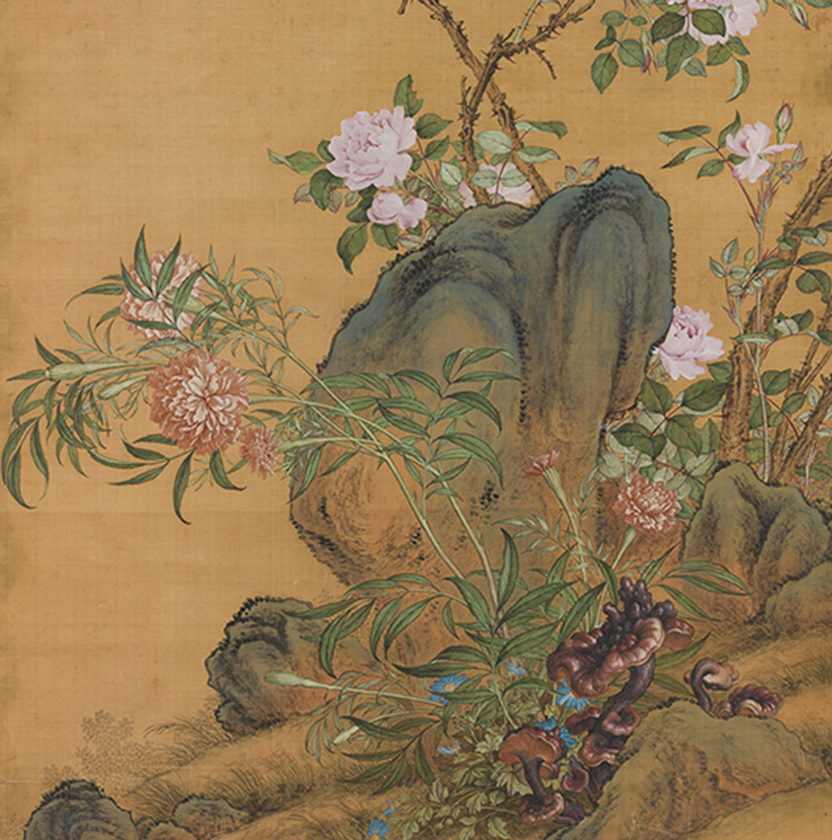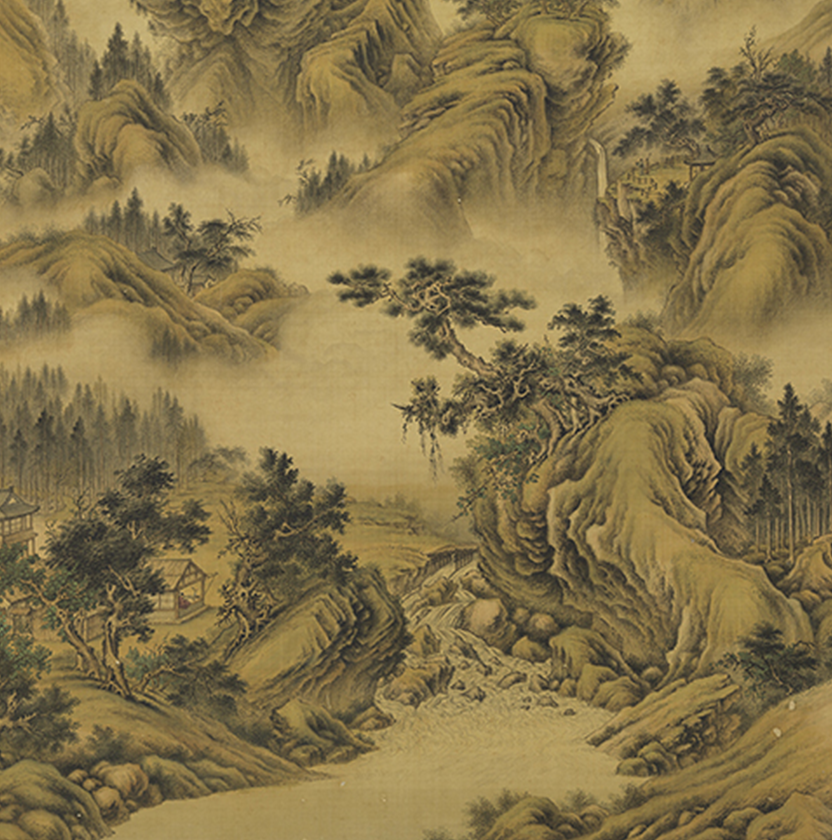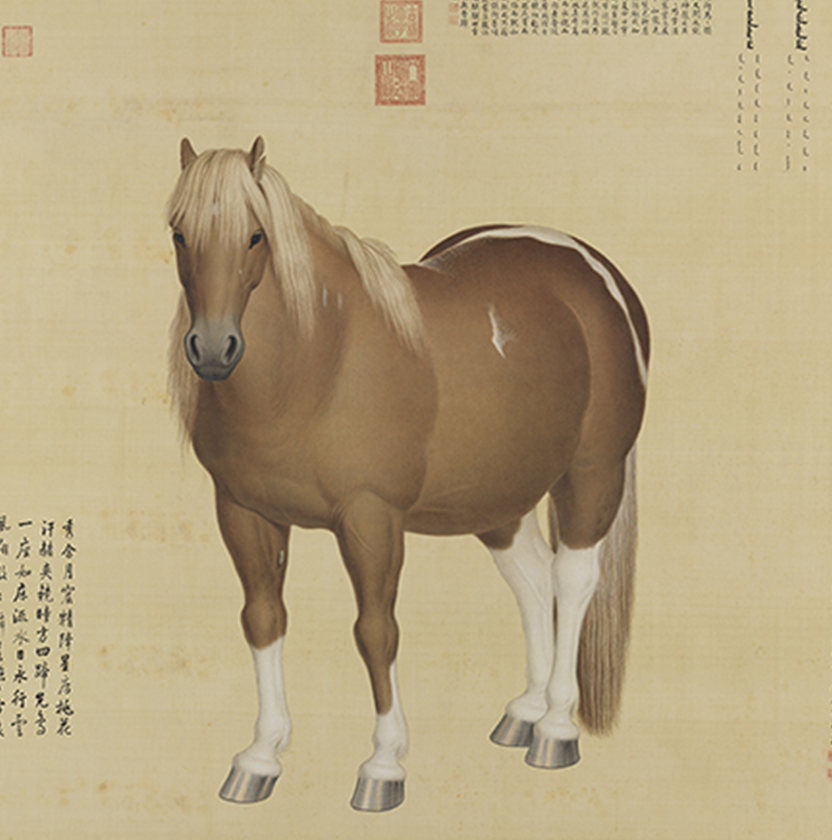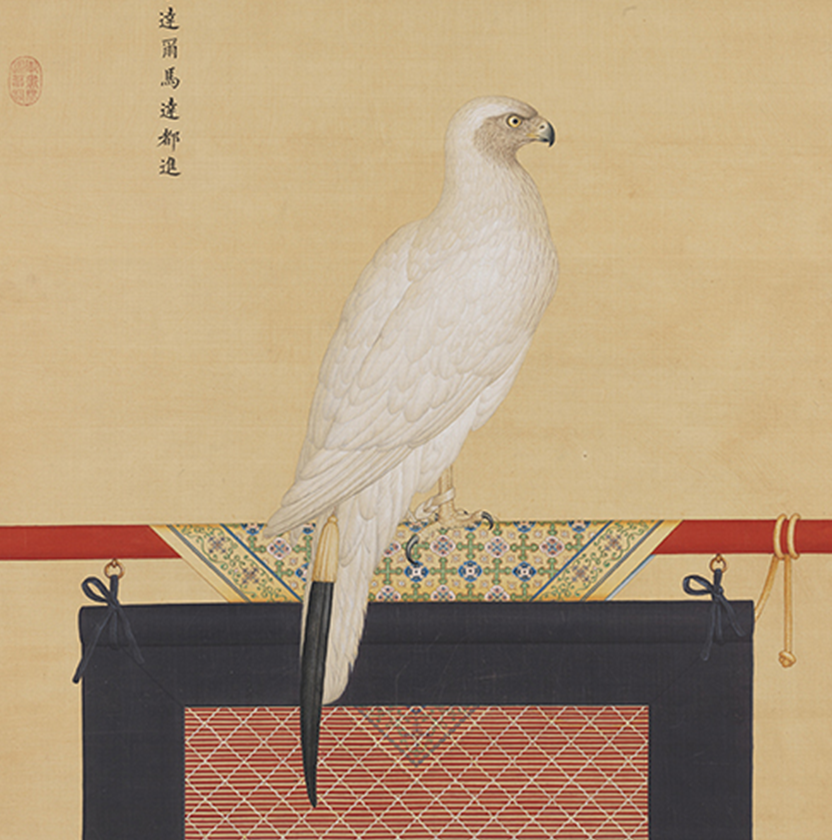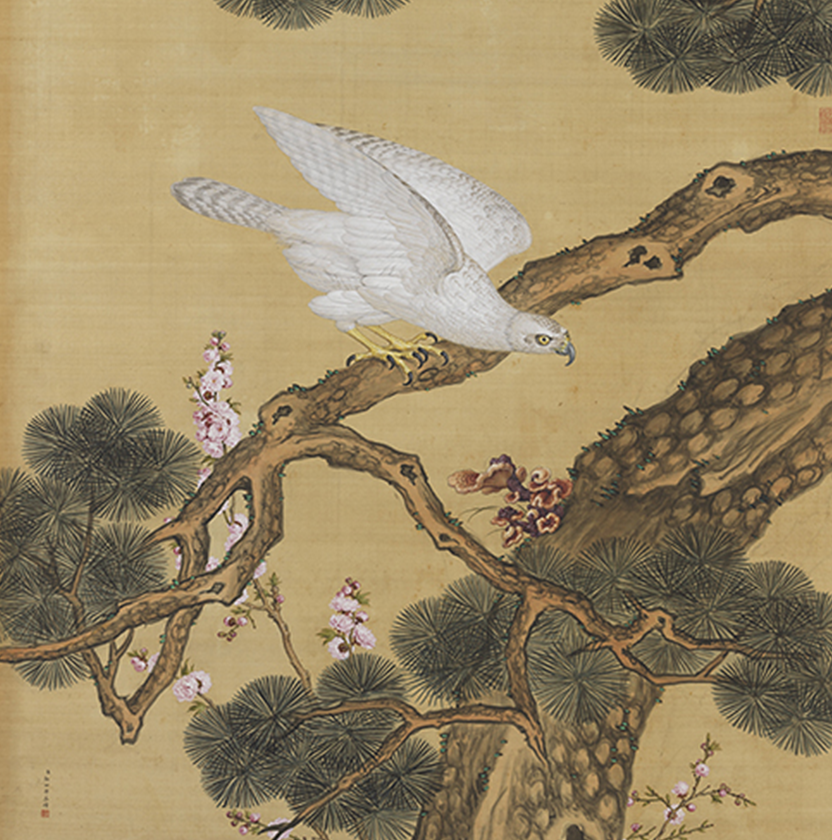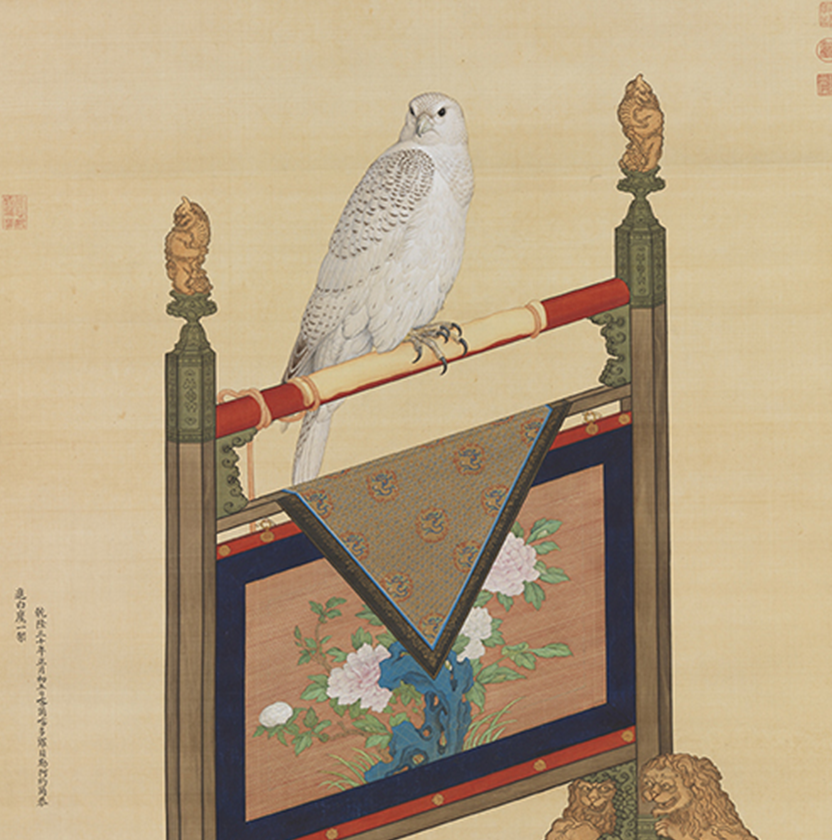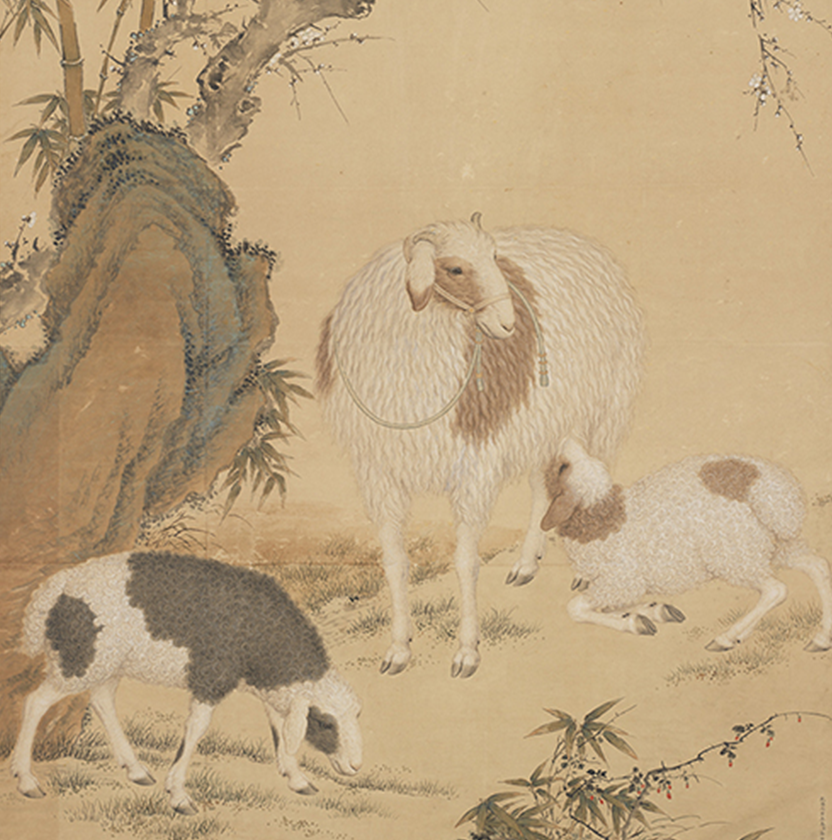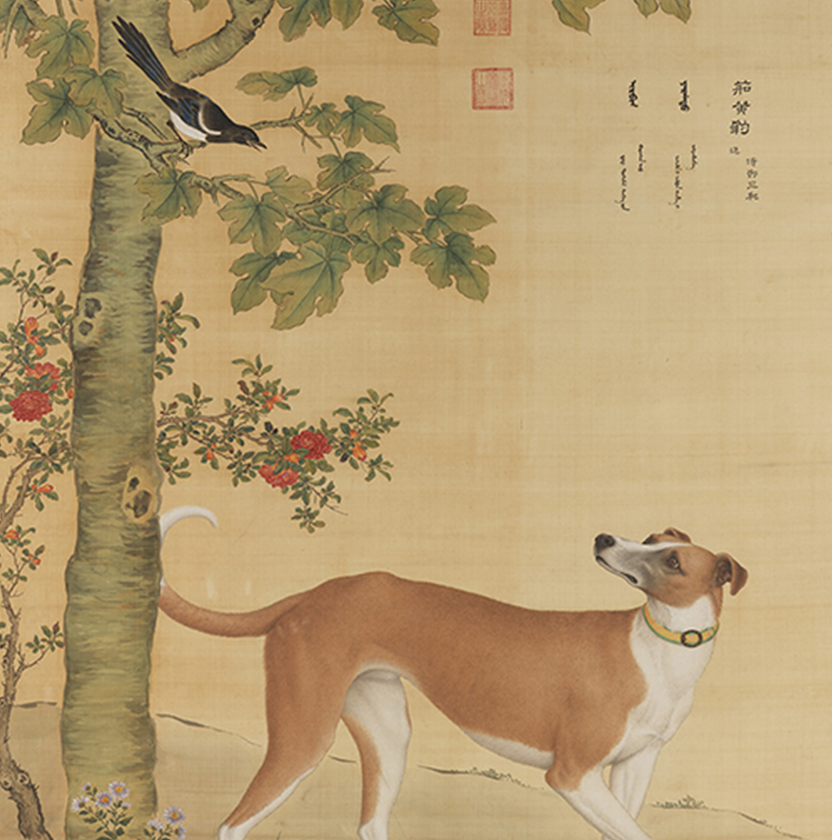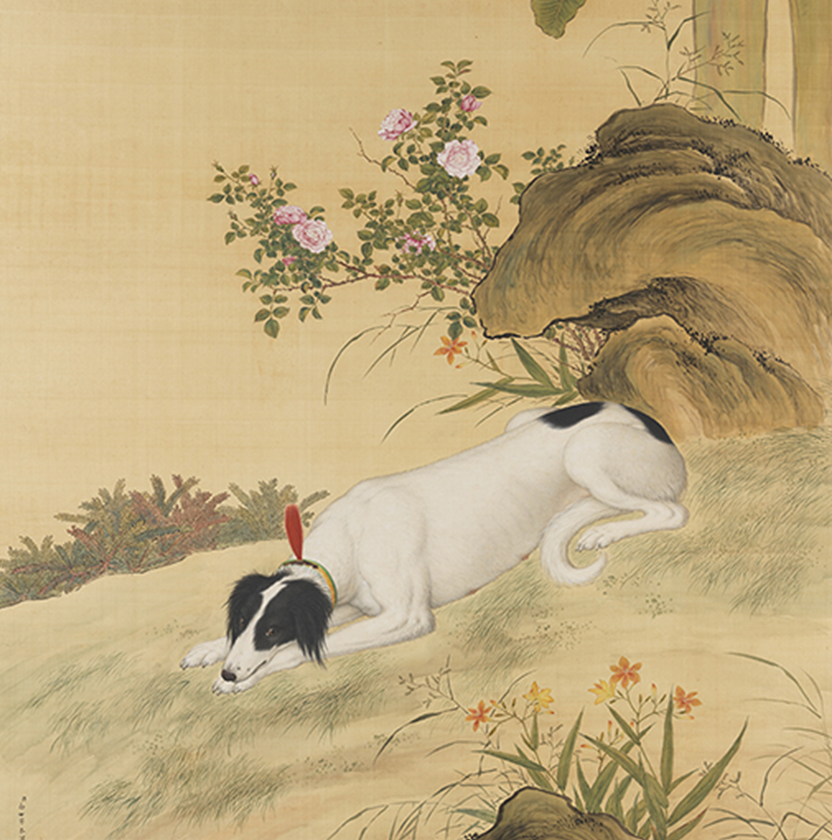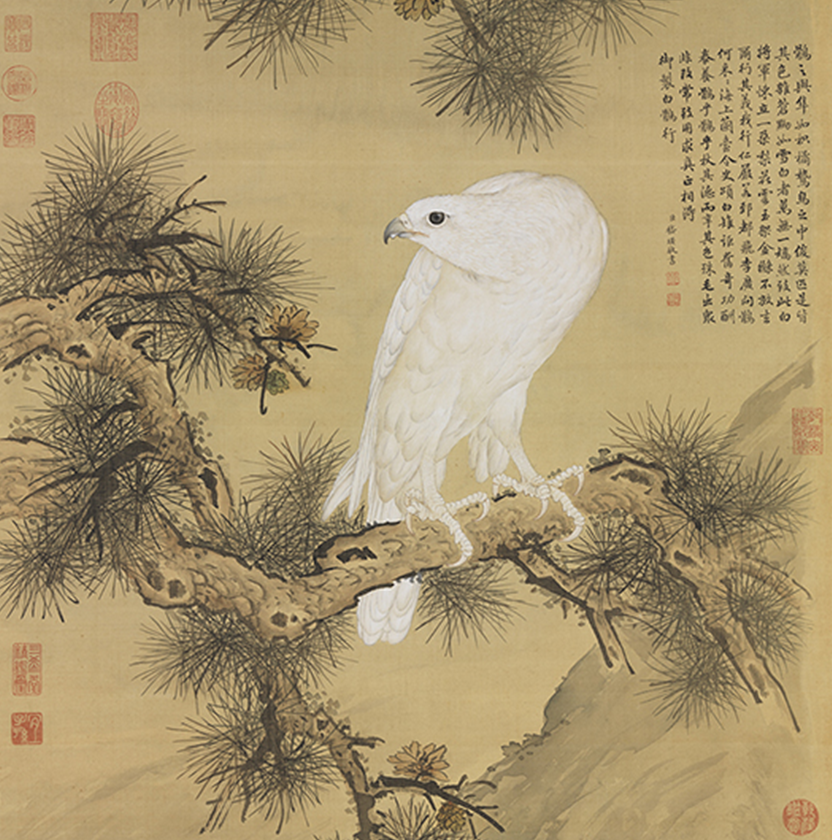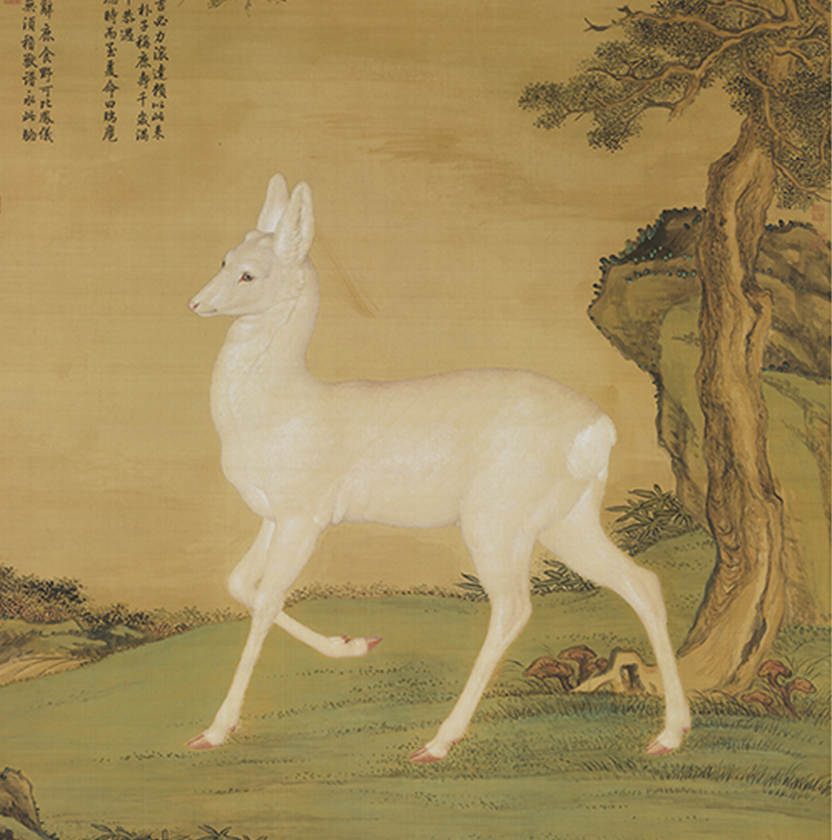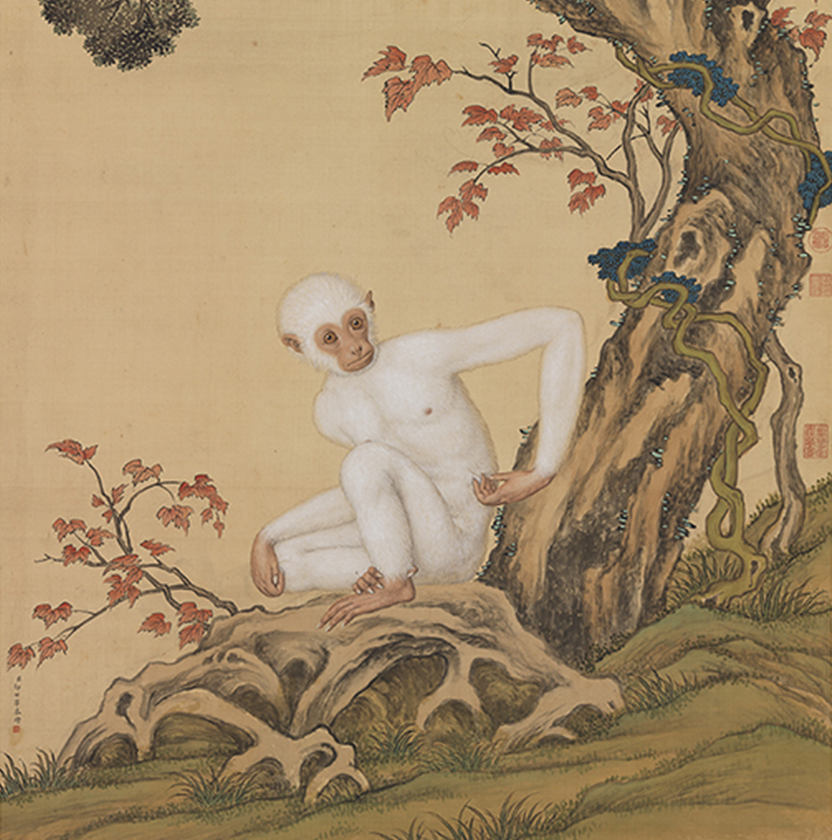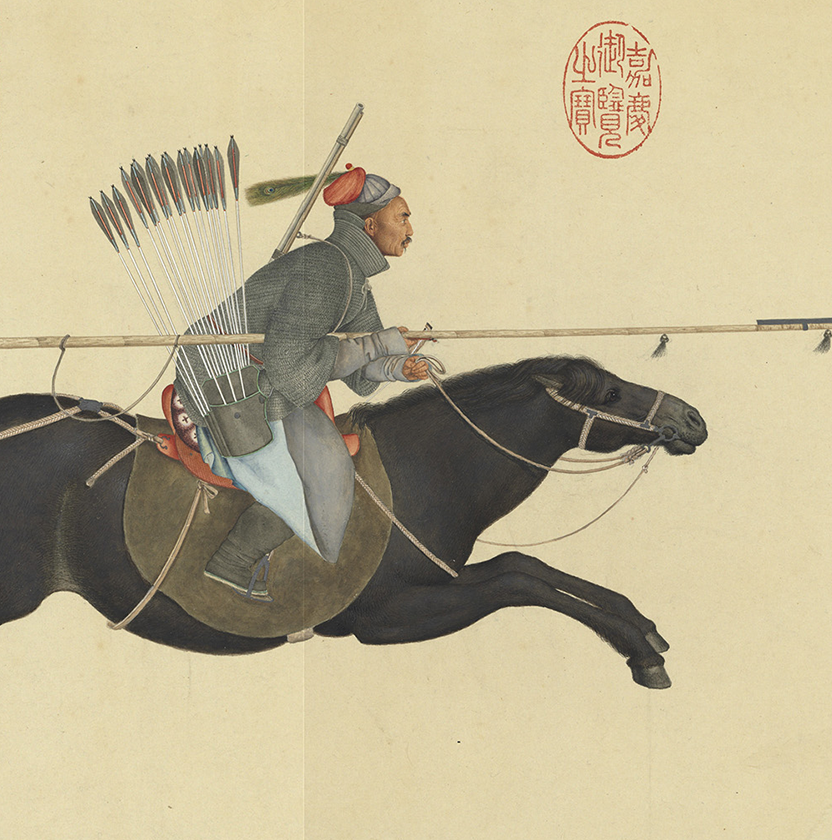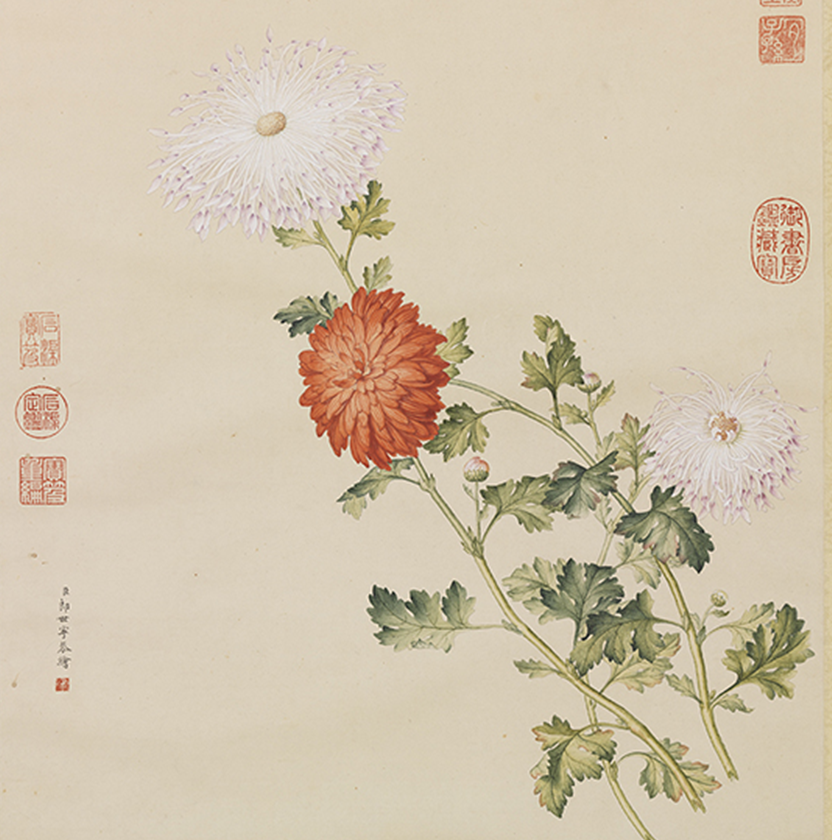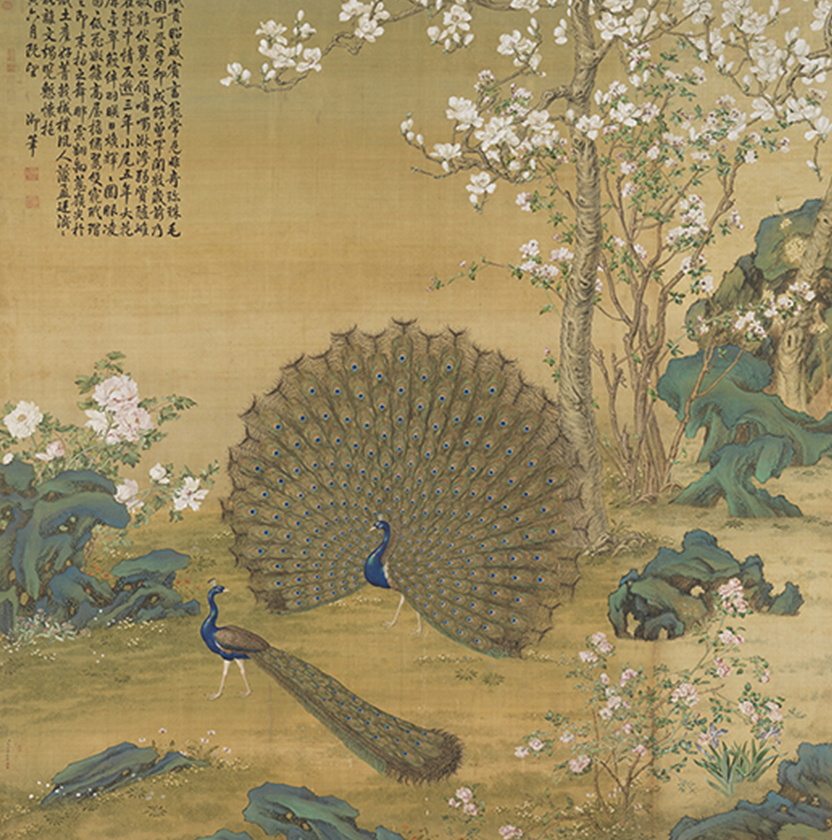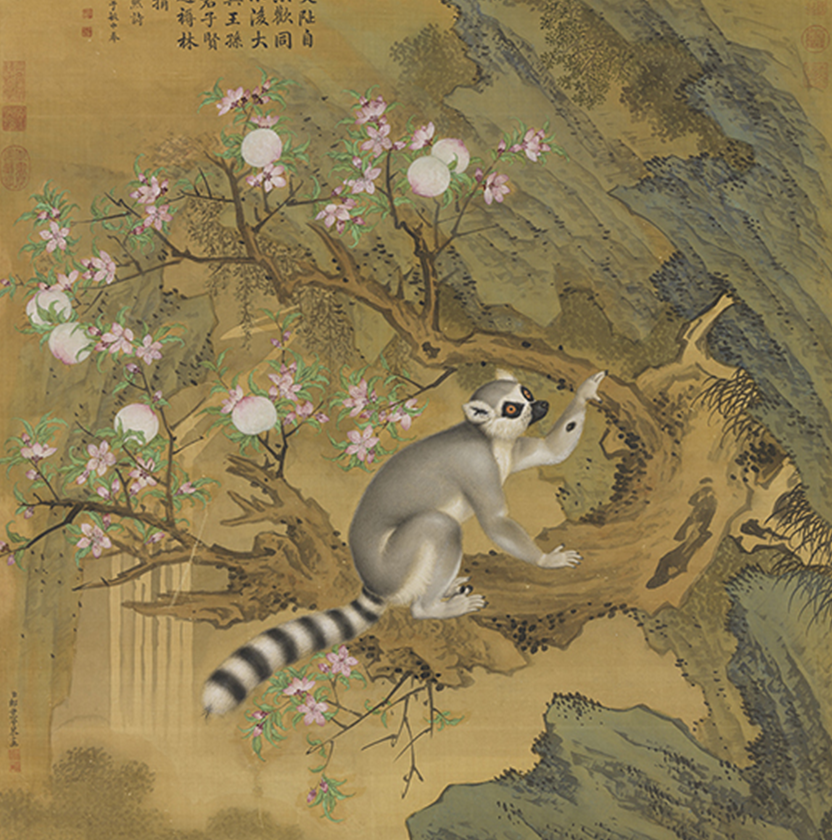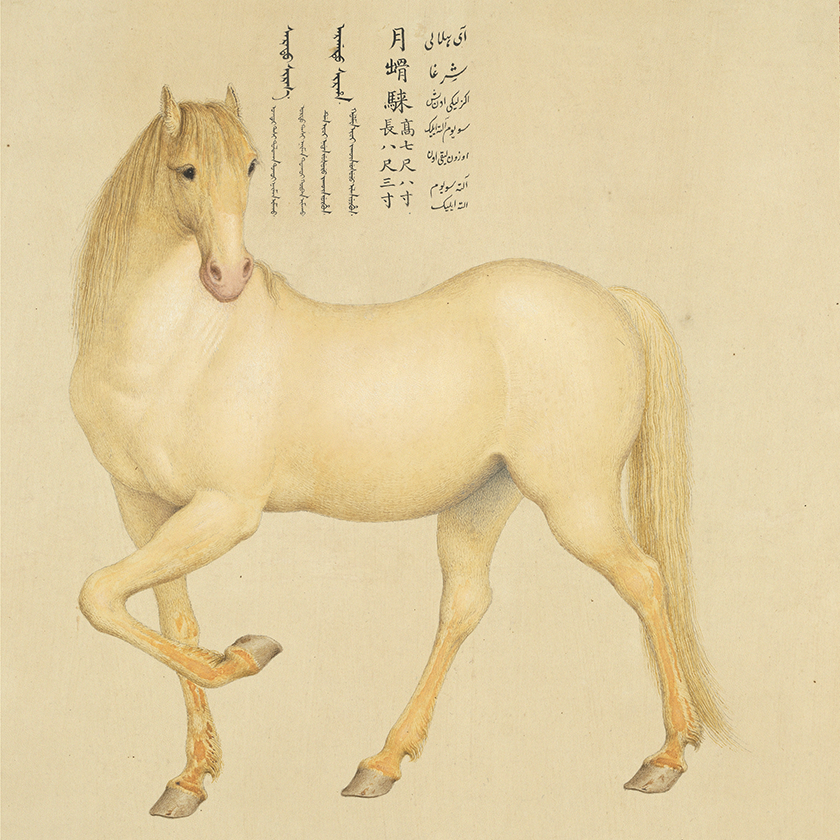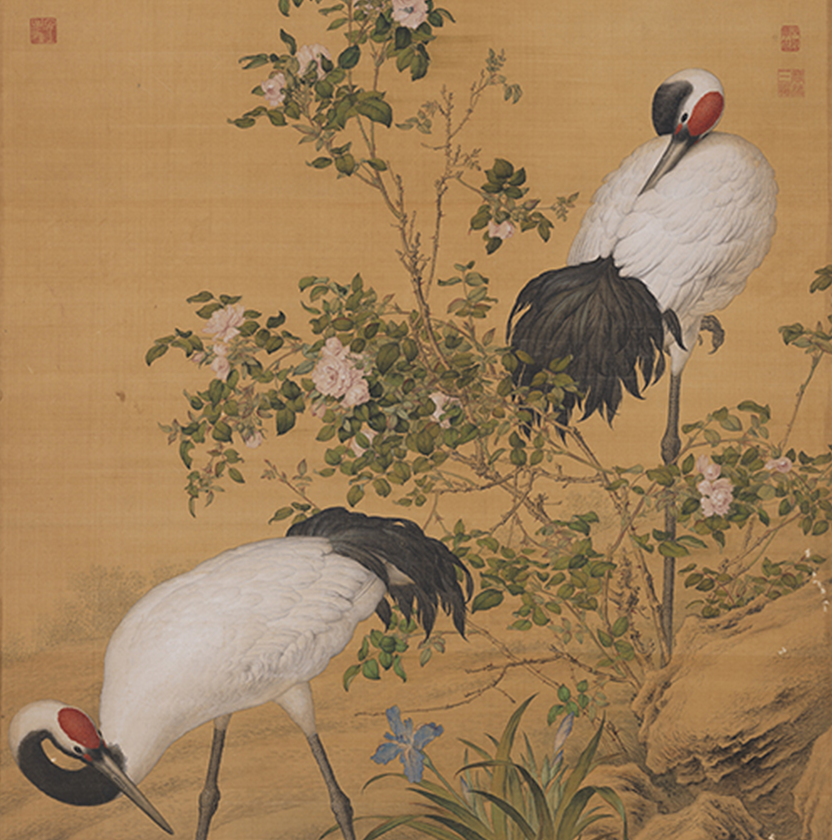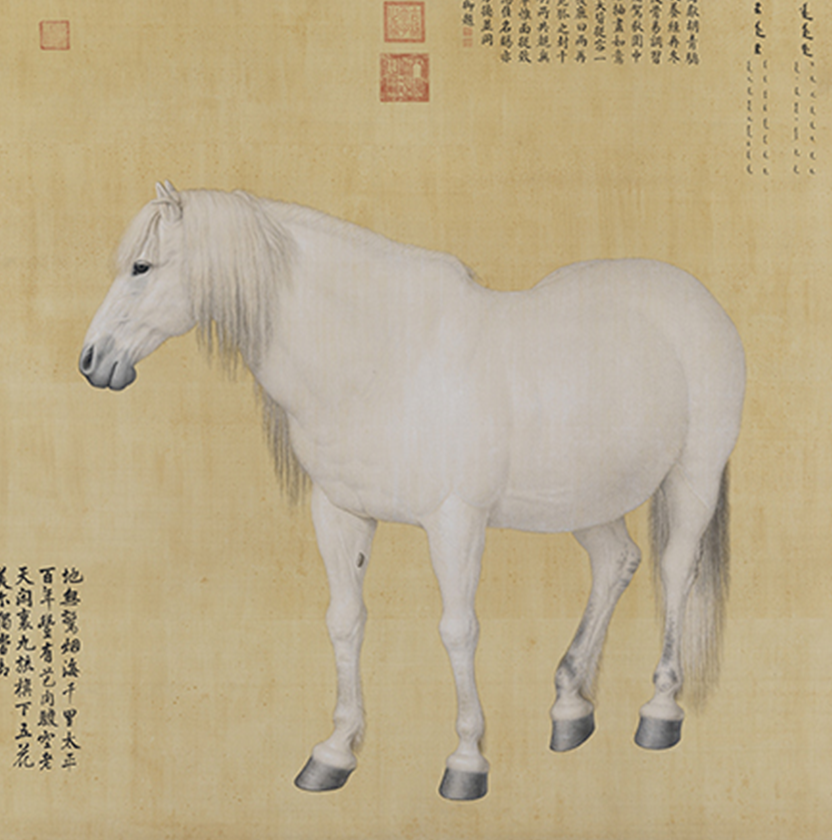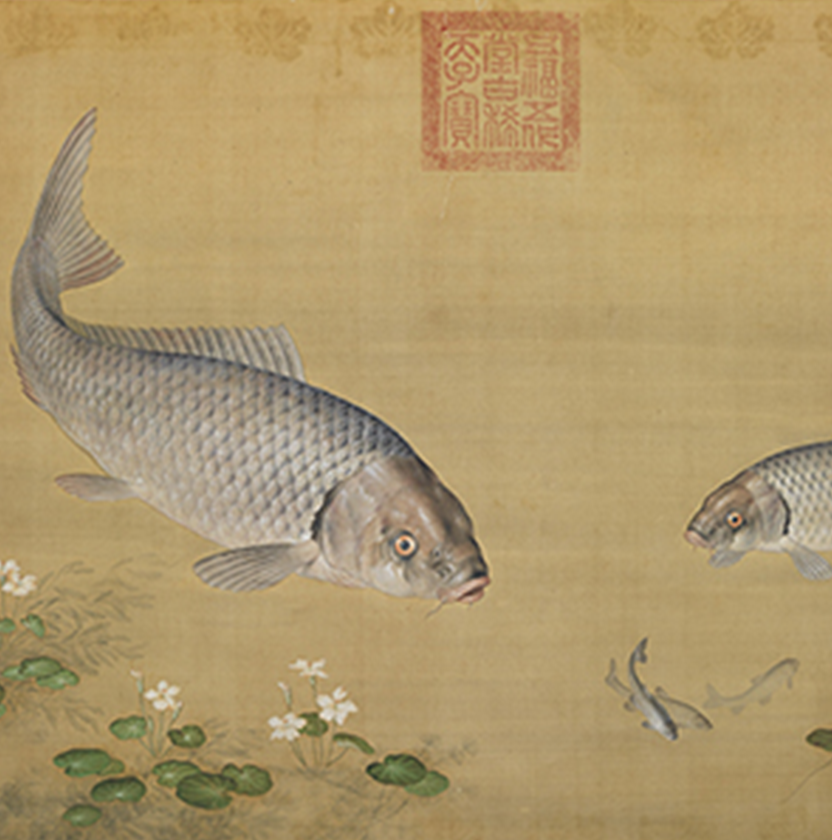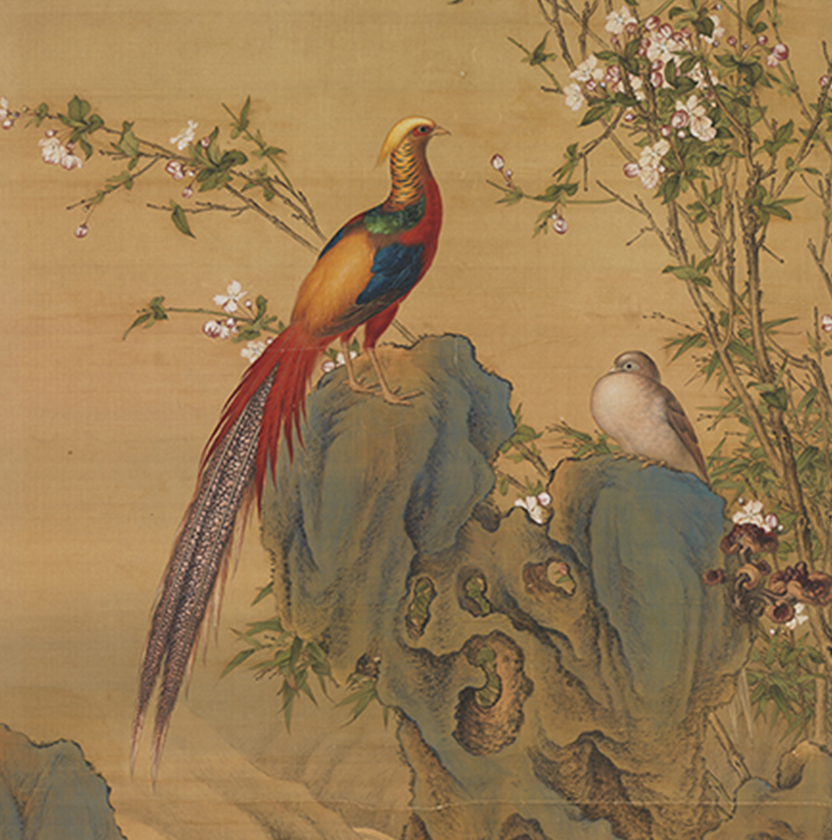Kangxi Reign(1662-1722)
to Lang Shining
Tobias and the Archangel Raphael Attributed
- Oils on canvas
- 272.5 × 181.5 cm
- (Giuseppe Castiglione, 1688-1766), Qing dynasty Collection of Pio Istituto Martinez, Genova, Italy
The subject of this painting comes from the "Book of Tobit" in the Catholic Old Testament , the first section of the Christian Bible. In it, the son of Tobit, Tobias, is sent by his father to a distant land to collect a payment and is accompanied by the family dog. Due to the difficulty of the journey, God sent the archangel Raphael in human form to go with him. Heeding the angel's instructions, Tobias caught a giant fish and removed its heart, liver, and gall bladder, which he later used to drive away a demon and make medicine to cure his father's blindness. The strong lighting in this painting symbolizes the glory of God as the angel points the way. Tobias, basking in God's grace, appears gutting the fish. The method of treating the luster on the surface of the dog, fish, water, and hair can also be found in works that Castiglione did after arriving in China. The dramatic lighting and vast areas of shade, however, are rare in his later works.
Yongzheng Reign(1723-1735)
Gathering of Auspicious Signs
- Lang Shining (Giuseppe Castiglione), Qing Dynasty
- Hanging scroll, ink and colors on silk
- 173 × 86.1 cm
In this painting is a celadon vase with an arrangement of auspicious plants such as dualblossom lotuses and stalks of millet with two ears of grain, plants that have been used in painting since the Song and Yuan dynasties to symbolize sagacious rule. Giuseppe Castiglione signed his name in Chinese with the "Song-script" style of Qing court publications and included a date equivalent to 1723, the first year of the Yongzheng emperor's reign, making it his earliest dated work. An elevated point of view has been taken, allowing the viewer to peer into the neck of the vessel. Castiglione also used white pigment to highlight the shine on the glaze, enhancing the volumetric effect of this porcelain vase. As for the plants, Castiglione excelled at rendering gradated areas of color to express threedimensionality and shading with a single source of light. The coloring overall is exceptionally refined, making the motifs appear as if radiating with brightness. The painting is a masterful example of how Castiglione translated Chinese subject matter using Western techniques. The vase shown here also appears similar to an imitation Ru-ware celadon with linear patterns in the collection of the National Palace Museum.
Vase of Flowers
- Lang Shining (Giuseppe Castiglione, 1688-1766), Qing dynasty
- Hanging scroll, ink and colors on silk
- 113.4 × 59.5 cm
This hanging scroll is undated, but the style of Giuseppe Castiglione's signature ("Respectfully painted by Your Servitor, Lang Shining") is similar to that on "Gathering of Auspicious Signs." According to archives from the Qing dynasty court, in the third lunar month of the Yongzheng emperor's fifth year (1727), Castiglione went to the Old Summer Palace (Yuanmingyuan) to paint a twin-blossom peony, perhaps the one shown in this scroll. The peony petals here were outlined with light red and then shaded with areas of color to give them volume, being also treated with white pigment to suggest a slight shine. The stems and leaves are likewise shaded for a three-dimensional effect, once again demonstrating Castiglione's new style adapting Western techniques. The form of the porcelain vase is unique as well, being similar to an angular Xuande underglaze-blue of the Ming dynasty with morning-glory decoration. Castiglione used a special way of interpreting the glaze, reducing the intensity of the blue while heightening the luster of the surface, adding white lines to enhance details for the reflection as well. This painting fully conveys a conscious attitude toward manipulating the effects of light and shadow.
Long-haired Dog Beneath Blossoms
- Lang Shining (Giuseppe Castiglione, 1688-1766), Qing dynasty
- Hanging scroll, ink and colors on silk
- 123.2 × 61.9 cm
This painting depicts a small reddish-brown dog by a lake rock and peach blossoms in a garden setting. The blossoms come from an old peach tree growing in the lower right corner and extending out of the composition. Even a few new sprigs with blossoms emerge from the dense and gnarled roots, suggesting that the tree is still full of life. In the background is a large decorative lake rock, its convoluted form complementing that of the old tree. The rendering of the little dog is quite precise and endearing, a sense of motion inherent in it despite the stillness. In mid-step, its attention appears to have been caught by something outside the composition, making it stop to look back. Giuseppe Castiglione used extraordinary refinement and realistic techniques to portray the animal, conveying not only its three-dimensionality but also the luster of its hair. Capturing both the subtleties of formal likeness and inner spirit, the latter became an especially important criterion for determining the success of an animal painting. This work is undated, but according to Qing court archives, Castiglione made alterations in the second lunar month of Yongzheng's fifth year (1727) to a painting of a small "date-red" dog, most likely referring to the one here.
Immortal Blossoms in an Everlasting Spring
- Lang Shining (Giuseppe Castiglione, 1688-1766), Qing dynasty
- Album leaf, ink and colors on silk
- 33.3 × 27.8 cm
This set of sixteen album leaves includes the following flowers, fruit, or plants: tree peony, peach blossom, herbaceous peony, flowering crab apple and magnolia, corn poppy and fringed iris, yellow prickly rose, carnation, cherry, poppy, purple and white lilacs, tiger lily and peony blossom, bamboo and morning glory, lotus and arrowhead, pea blossom and millet, cockscomb, and chrysanthemum. Eight of the leaves also include birds, the contents corresponding to a record of a painting entitled "Album of Flowers" by Giuseppe Castiglione in Third Edition of Treasured Boxes from the Stone Moat , one of the Qing court catalogues. The opposing leaves for each painting here are blank, the last one signed in "Song-script" as "Respectfully painted by Your Servitor, Lang Shining." Judging from the painting style, it would appear to be a masterpiece from the Yongzheng reign (1723-1735). Castiglione not only painted the sixteen leaves in this album with meticulous care and coloring, the compositions are also quite innovative. In particular, he was able to reach beyond the traditional portrayal of birds in Chinese painting to achieve fantastic results in Western perspective and shading as well. Many places in the depiction of the birds and flowers reveal touches of light and shadow, the artist showing adept skill at using white pigment to highlight bright areas. The style throughout again relates to Castiglione's early Yongzheng manner.
Eight Horses
- Lang Shining (Giuseppe Castiglione, 1688-1766), Qing dynasty
- Hanging scroll, ink and colors on silk
- 139.3 × 80.2 cm
Two herders and eight fine horses of various colors are shown at peace and leisure on a grassy plain. The artist Giuseppe Castiglione employed Western methods of chiaroscuro (shading) and one-point perspective to portray these steeds of various physical attributes, their likenesses similar to those found in the "One Hundred Horses" handscroll. Castiglione also conveyed the background with shifting clouds and light, the legs of the figures and horses even casting shadows. Such detail and fidelity to nature express Castiglione's consummate skill in formal likeness. Therefore, this scroll may be surmised as having been completely done by Castiglione not long after arriving in China.
The Qianlong emperor used the ancient story of King Mu's eight great horses in the Zhou dynasty (during the tenth century BCE) to remind himself that diligence in government brings peace and prosperity to the people, serving to inspire him as a ruler. Using his Chinese name, Giuseppe Castiglione's signature in Song-style script appears in the lower right corner: "Respectfully painted by Your Servitor, Lang Shining." In it, the characters are upright and even, a characteristic of his signatures from the Yongzheng reign (1723-1735).
Myriad Longevity in an Everlasting Spring
- Lang Shining (Giuseppe Castiglione, 1688-1766), Qing dynasty
- Hanging scroll, ink and colors on silk
- 117.4 × 56.3 cm
This hanging scroll portrays a scene of rocks and plants in an imperial garden. Behind are monthly rose and in front pink carnations with blue western chrysanthemums and some spirit fungus growing nearby. The plants are all rendered with painstaking detail and shading, the focus being on graded colors to create a textured effect. The rocks and slope, however, are closer to traditional Chinese methods of painting and differ from the manner found in "Long-haired Dog Beneath Blossoms." In that painting, Giuseppe Castiglione used short brown strokes to create a special effect of the ground, but here they are changed to longer black lines with ink washes and dots to create the slope and rocks, an effect closer to the traditional Chinese painting method of texture strokes and ink dots. According to archival records from the Qing court, Castiglione often collaborated with other Chinese painters after the seventh year of the Yongzheng emperor's reign (1729); Tang Dai, for example, often did landscape portions. This hanging scroll perhaps represents this type of collaboration.
Landscape
- Lang Shining (Giuseppe Castiglione, 1688-1766), Qing dynasty
- Hanging scroll, ink and colors on silk
- 143.2 × 89.1 cm
Clouds and mists linger amongst lush mountains rising layer upon layer in this painting with village houses, pavilions, and small bridges scattered here and there. Giuseppe Castiglione has combined traditional methods of Chinese texturing and outlining with a technique akin to drawing, creating a completely new manner for the motifs. The tree leaves delicately range from dry to moist and light to dark, the coloring also luminous and beautifully refined. The faint mists increase the feeling of remote distance for a sense of space in the painting.
In addition to his proficiency in various styles, Castiglione also dabbled in literati painting, learning from the court artist Tang Dai (1673-after 1752), who had studied under the Orthodox master Wang Yuanqi (1642-1715). The forms of the mountaintops, arrangement of the trees, texturing, and "moss dots" all reveal Castiglione's instruction from Tang Dai. In fact, the two were often ordered to collaborate, thereby placing Castiglione within the "Orthodox Style" of painting circles in the early Qing dynasty
Qianlong Reign(1735-1796)
Ten Steeds ("Bolting Mist")
- Lang Shining (Giuseppe Castiglione, 1688-1766), Qing dynasty
- Hanging scroll, ink and colors on silk
- 240 × 270.5 cm
Castiglione was ordered by the court to paint from life fine steeds sent from the western regions as tribute in 1743. Collectively known as "The Ten Steeds", these large works are almost life-size renderings. He added Western painting techniques of shadow and perspective to Chinese traditional methods to create colorful yet realistic portrayals. This work is a portrait of one of the steeds known as Bolting Mist.
"Jade Blossom" Goshawk
- Lang Shining (Giuseppe Castiglione, 1688-1766), Qing dynasty
- Hanging scroll, ink and colors on silk
- 143.8 × 78.1 cm
Written in "bafen" clerical script on this painting is the name of the bird shown here, "Jade- Blossom," referring to this white goshawk, which is rare. It has yellowish skin for its face and legs as well as dark talons. The dark beak with a tint of blue curves prominently at the end and is used to tear the flesh from its prey. Giuseppe Castiglione was frequently ordered to record in painting the birds of prey submitted to the Qing court as tribute, the one here depicted on a red crossbar, its leg tied with a leather belt to the stand, over which is draped a brocade with a screen fixed to loops on the crossbar.
Da'ermadadu, a member of the Horqin tribe in what is now Inner Mongolia, took as his wife the eldest daughter of the Kangxi emperor's second eldest son, Crown Prince Yunreng (1674-1725). After the Yongzheng emperor ascended the throne, Da'ermadadu was promoted to the rank of Consort of the Imperial Princess. In 1750, he was bestowed with the title of Beile Prince under the Qianlong emperor. Since the inscription refers to him as "Beile Prince," this painting was most likely done after this year.
White Gyrfalcon
- Lang Shining (Giuseppe Castiglione, 1688-1766), Qing dynasty
- Hanging scroll, ink and colors on silk
- 178.2 × 119 cm
In the 29th year of Qianlong's reign (1764), the Muslim Khokand khan Erdeni (from what is now Xinjiang) presented a white gyrfalcon as tribute to the court and Giuseppe Castiglione was ordered to do a painting of it. The emperor also composed "Song on a White Gyrfalcon" to record the event in poetry as well. The gyrfalcon was the most prized among birds of prey, the pure white variety being especially precious. In the painting here, the shining eyes of the falcon in an untamed pose make it appear as if ready to take off and pounce on some unsuspecting prey below. Its beak is curved and sharp, the talons equally so. Castiglione used exceptionally refined methods to paint this bird from life, the treatment of the plumage pure and lustrous. The bird is on an old pine tree winding through the composition, the clusters of needles depicted as whorls in an almost decorative way. A 1764 record from the Ruyi Hall section of the archives from the imperial workshops indicates that Fang Cong (fl. ca. 1751-1778) added this part of the painting. Fang was a student of Zhang Zongcang (1686-1756) and a painter of relatively long tenure at the Qianlong court.
White Falcon
- Lang Shining (Giuseppe Castiglione, 1688-1766), Qing dynasty
- Hanging scroll, ink and colors on silk
- 179.9 × 99.2 cm
This trained falcon appears at the court perched on a stand with gleaming white plumage speckled gray and brown on the back of its head and wings. The red crossbar has a soft leather pad for the falcon to grip and protect its talons. Below, the stand is draped with a piece of brocaded cloth over the screen to prevent the rope tied to the bird's leg from becoming tangled on the crossbar. The stand, though quite detailed and realistic, is not from the hand of Giuseppe Castiglione, who depicted the falcon. According to a record from the archives of the imperial workshops, in the first lunar month of the year this falcon was submitted to the court as tribute (1765), the painter Yao Wenhan (fl. ca. 1742-1789) took part in rendering the stand, screen, and brocade of a work.
The Khalhka Mongol Beile Ayur presented this white falcon as tribute in that year, this hanging scroll representing the latest signed work by Castiglione. He did it at the age of 77, dying the following year of illness in Beijing.
Beginning a Peaceful Year
- Lang Shining (Giuseppe Castiglione, 1688-1766), Qing dynasty
- Hanging scroll, ink and colors on silk
- 228.5 × 138.3 cm
The Qianlong emperor named this painting (literally "Beginning Peace") in reference to the subject of three sheep (or goats). In Chinese, three such animals ("sanyang") is a homonym for "three yang," an auspicious trigram of divination in The Book of Changes. The combination of the two binomes into a four-character title for "Three Yang (Sheep) for a Peaceful Start" is meant to convey heavenly blessings for peace in the upcoming year. Giuseppe Castiglione has rendered the sheep here against the backdrop of a garden rock, verdant bamboo, and white plum blossoms, the easygoing brushwork of which was perhaps by a Chinese court painter. Also, the inscription indicates the scroll was done in the eleventh year of the Qianlong reign (1746), when Castiglione was 58 years old. The ewe seen here has wavy wool as a lamb kneels at its side and suckles; another lamb feeds on grass nearby. Sheep are known for their gentle nature and passive herding, the Holy Bible using it as a symbol of humility and obedience.
Castiglione skillfully portrayed this subject, which has deep-seated connotations in Western and Chinese history, conveying both imperial sentiment and perhaps personal conviction as well.
Ten Fine Hounds ("Tawny-Yellow Leopard")
- Lang Shining (Giuseppe Castiglione, 1688-1766), Qing dynasty
- Hanging scroll, ink and colors on paper
- 247.5 × 163.7 cm
In 1747, Giuseppe Castiglione is recorded as being ordered to do ten paintings of fine hounds, which probably corresponds to this series in the National Palace Museum collection. The dogs appear like portraits, the paintings bearing inscriptions in Chinese, Manchu, and Mongolian with their names and who presented them as tribute. The rendering of the dogs is precise to the last detail, while the backgrounds are sketchier. For this reason, Castiglione is probably the artist who painted the dogs and others did the backgrounds, making this a collaborative project. "Tawny-Yellow Leopard," the hound shown in this painting, was presented by Vice Minister Sanhe (?-1773). The dog looks back at a magpie screeching from a paulownia tree above. Pomegranate and chrysanthemum blossoms also embellish the scene. The dog's gentle eyes and pleasingly lustrous hair make it appear quite lifelike. "Tawny Yellow" is the name of fine hound in the past, here not only alluding to antiquity but also to the color of the dog's hair.
Ten Fine Hounds ("Sudden-Flight Magpie")
- Lang Shining (Giuseppe Castiglione, 1688-1766), Qing dynasty
- Hanging scroll, ink and colors on silk
- 247.2 × 164 cm
This is a portrait of "Sudden-Flight Magpie," one of the "Ten Fine Hounds." The dog was presented to the court by Bartu (1674-1753), who had inherited the title of "Prince Kang of the First Rank." The dog is shown lying on the ground below a rock and monthly rose with plantain in the background. Looking askance at the flowers, it appears in a lazy yet lovable manner, the artist skillfully conveying its personality. The long skull and slender snout, along with its body type, make it similar to a European greyhound, even though it has long hairy ears. A similar breed of dog with hairy ears, however, does exist and is originally from northern China. Called a "Chinese hound," it is probably the breed of dog shown here. Nine of the hounds in this series by Giuseppe Castiglione were included in an album of hound paintings by Ignatius Sichelbart (Ai Qimeng, 1708-1780), another Jesuit missionary-painter at the Qing court. Now in the collection of the Beijing Palace Museum, the backgrounds in those works are different, however. Thus, via copying, Castiglione's originals were disseminated and gradually canonized at the court.
White Bird of Prey
- Lang Shining (Giuseppe Castiglione, 1688-1766), Qing dynasty
- Hanging scroll, ink and colors on silk
- 123.8 × 65.3 cm
The branch of an old pine tree extends across the composition with a white bird of prey (falcon) perched on it, a cascade descending into the valley behind. The falcon with its short flat head peers out, its eyes sparkling black. It also has a pointed beak and muscular legs with sharp talons. The ruling Manchu at the Qing court often received birds of prey as tribute, reflecting the common interests and heritage they shared with northern nomadic peoples. In the sixteenth year of the Qianlong emperor's reign (1751), the high court official Fuheng (1720-1770) presented this white bird of prey as tribute, and Giuseppe Castiglione was ordered to paint it from life, the pine tree and landscape with a waterfall added by another court artist. The compact size of the falcon makes it agile in flight, and known for its ferocity, it often served as a symbol of courage and victory. The Grand Academician Ji Huang (1711-1794) transcribed "Imperially Produced Song on a White Bird of Prey," respectfully referring to the falcon as a "White General."
Auspicious Roe Deer
- Lang Shining (Giuseppe Castiglione, 1688-1766), Qing dynasty
- Hanging scroll, ink and colors on silk
- 216.2 × 144.6 cm
In the autumn of 1751, the Qianlong emperor accompanied Empress Dowager Chongqing on a tour of the summer mountain retreat. Qianlong also traveled to the Mulan hunting grounds, where he was entertained to a banquet by Mongolian nobility. The Mongol Taiyiji Bilig-un dalai presented a roe deer as an offering, its fur as white as snow and eyes sparkling red. According to Ge Hong's (283-343) Baopuzi , the deer has a lifespan of a thousand years, turning white after reaching the age of 500. In this painting, the white roe deer has large ears and eyes, a long neck, and a short tail, serving as a symbol of good fortune and nobility as well. The year 1751 also happened to be the Empress Dowager's sixtieth birthday, a major event in traditional Chinese life, so the Qianlong emperor ordered Giuseppe Castiglione to do this painting and composed "Poetry on an Auspicious Deer" to bless his mother for a long life. Castiglione painted the animal, while the rocks, slope, mahogany, and spirit fungus were added by another court artist, Yao Wenhan (fl. ca. 1742-1789).
White Gibbon
- Lang Shining (Giuseppe Castiglione, 1688-1766), Qing dynasty
- Hanging scroll, ink and colors on silk
- 151.2 × 91.9 cm
This is a collaborative painting in which Giuseppe Castiglione did the primate and another court artist, who did not leave his signature, rendered the background. Traces of the underlying draft can be found in the painting, the final version more or less following its composition. Castiglione first painted the gibbon, and the other artist carefully filled in the background parts and avoided the animal. In order to faithfully portray the primate's body, Castiglione used opaque white pigment for highlighting the shiny parts of its hair. In doing so, he may have consulted the skills of seventeenth-century European oil painting to convey the luster of fur, creating a contrast with the background, in which the painting method focuses on brush and ink. According to records, in 1754 Castiglione was ordered to copy a "White Gibbon" painting by the Ming emperor Xuanzong (1399-1435). Though perhaps referring to this work, no similar painting by Xuanzong survives today for comparison.
Ayusi Sweeping Bandits with a Lance
- Lang Shining (Giuseppe Castiglione), Qing Dynasty
- Hand scroll, ink and colors on paper
- 27.1 × 104.4cm
Ayusi (birth and death dates unknown) was a Mongol Dzungar who submitted to and later fought for the Qing court. In the twentieth year of Qianlong's reign (1755), the Dzungar Khan Dawachi colluded with Tsarist Russia and in a pincher attack by Qing forces, he was forced to flee to Gädän-Ola, where he put up stubborn resistance. While there, Ayusi led a nighttime cavalry raid on the Dzungar rebel camp, scattering them. Though Dawachi managed to escape, he was captured later by Khojis. Ayusi was commended for his merits in battle and Giuseppe Castiglione ordered to do an oil portrait and a large painting of "Victory at the Military Camp." Ayusi's portrait was also transferred to this handscroll painting of him racing on horseback with a lance, arrows, and a rifle.
Here, Castiglione has completely done away with the background, realistically portraying Ayusi wearing a peacock-feather warming cap, an overcoat to protect against arrows, and a musket slung over his shoulder. With a bag of arrows at his waist, he holds onto reins with one hand and a lance with the other, leading his horse against the enemy.
Chrysanthemums of the West
- Lang Shining (Giuseppe Castiglione, 1688-1766), Qing dynasty
- Hanging scroll, ink and colors on silk
- 63 × 42.8 cm
The chrysanthemum is native to China but later spread to Europe. Several varieties were reintroduced to China in the early eighteenth century and called "Western chrysanthemums." Coming in many colors, one of the varieties is "round as a ball" and another "flat as a dish or a wheel." Because of their novelty at the time, the Qianlong emperor ordered Zou Yigui to paint a "Manual of Chrysanthemums," and many varieties were cultivated in the imperial gardens.
This painting depicts a few stems of these Western chrysanthemums, the blossoms rendered using opaque washes and the stems and leaves adorned with pure and translucent ink tones. The red blossom is shown as round as a ball and radiantly colored with a golden touch. In full bloom, even its small center can be seen. The white blossoms are like dishes with a yellow head and petals ivory in color tinged with pink. Quite popular at the time, today this kind is rare. Fortunately, Giuseppe Castiglione has left behind an indelible impression of it with his marvelous brushwork for later generations to appreciate. A record from 1758 mentions an order to mount a Castiglione hanging scroll painting on paper of chrysanthemums, perhaps referring to this work.
ock Spreading Its Tail Feathers
- Lang Shining (Giuseppe Castiglione, 1688-1766),Qing dynasty
- 328 × 282 cm
The male peafowl, or peacock, is renowned for its circular display of long and opulent tail feathers, which can reach several feet in length over five years. The feathers are usually kept folded behind its body, but when expanded for display, they shine with iridescent beauty and dazzling "eye" patterns. This painting is a scene in a palatial garden designed with "blue-and-green" rocks as well as magnolia, peony, and cherry apple blossoms, further conveying the traditional auspicious idea of "wealth and nobility in halls of jade."
In the sixth lunar month of the Qianlong 23rd year (1758), Kumul from the western regions presented peacocks as tribute, the emperor composing poetry on "Peacock Spreading Its Tail Feathers," which is transcribed on this work. On the twelfth day of the seventh month of that year, the Ruyi Hall section of the imperial workshop archives records that Giuseppe Castiglione did a large hanging scroll painting on white silk of a peacock spreading its tail feathers with background scenery by the eighteenth-century artists Fang Cong and Jin Tingbiao. The Qianlong emperor's instructions for the painting explicitly state that it should represent a "fusion" of Chinese and Western painting.
Macang Lays Low the Enemy
- Lang Shining (Giuseppe Castiglione), Qing Dynasty
- Hand scroll , ink and colors on paper
- 38.4 × 285.9cm
Macang was one of the meritorious officials in the Qing court's pacification of rebellious Dzungar tribes. In the Battle of Qurman, Macang penetrated enemy ranks and laid low the enemy with his bow and arrow. Although later injured, he continued to do battle. To commemorate his bravery, the Qianlong emperor ordered Giuseppe Castiglione to do this handscroll painting, to which the emperor added a long inscription to eulogize the event. In the painting, Macang has already shot the enemy, who slumps over on the horse with an arrow in his back. Macang had previously thrown his lance but missed, using his bow and arrow instead. The horses appear with legs aloft to indicate the speed of their gallop, and the background of the painting is otherwise blank to heighten the tension of the scene. This work on paper has a slightly different technique. Not only featuring washes, it also has fine lines and texturing for the faces, Macang's eyes being especially spirited to portray his intense concentration. Macang is unrecorded in the draft biographies of Qing historical figures, but this painting of him by Castiglione commemorates his important contribution to the Qing court.
Cochin Lemur
- Lang Shining (Giuseppe Castiglione, 1688-1766), Qing dynasty
- Hanging scroll, ink and colors on paper
- 109.8 × 84.7 cm
A ring-tailed lemur is shown here on the trunk of a peach tree, its branches full of pink blossoms and with seven large fruit. Giuseppe Castiglione employed fine, short strokes of light ink with gradations of color to suggest light and volume. Depicting the alternating rings of black and white as well as the animal's fluffy fur, he has made an accurate and realistic portrayal here. The background landscape was done mostly with traditional "axecut" texture strokes to which blue-and-green washes were added with scattered fine dots of ink, representing the work of the court artist Jin Tingbiao (?-1767). At the top of the painting is a transcription of "Imperial Poetry on a Cochin Lemur," which was composed in Qianlong's 26th year on the throne, or 1761. That year was also the seventieth birthday of Qianlong's mother, Lady Niuhuru (1692-1777), so this work was probably painted specifically to bless her with a long life.
Four Afghan Steeds
- Lang Shining (Giuseppe Castiglione, 1688-1766), Qing dynasty
- Hanging scroll, ink and colors on silk
- 40.7 × 297.1 cm
The Afghan state, referring to the northern part of modern Afghanistan, was located southwest of Badakhshan and represented the western-most tributary state in the Muslim reaches of the Qing Empire at the time. In the twelfth lunar month of the Qianlong emperor's 27th year on the throne (1762), Ahmad Shah Khan dispatched an emissary to present a gold-foil diplomatic credential with a gift of purebred Arabian horses, and in the following year Qianlong composed "Song on Four Afghan Steeds." In Giuseppe Castiglione's painting here, the bodies of the horses are full and handsome, their hair all different as he portrayed them from various angles. He also indicated a light source to provide shading to the hues and thereby give the horses a volumetric effect. The paintings feature inscriptions in Uighur, Chinese, Manchu, and Mongolian, indicating the name, height, and length of the horses. In doing so, the painting announces Afghan as a western tributary of the Qing and reflects the Manchu view of the Qing Empire as a multi-ethnic political entity.
Pair of Cranes in the Shade of Flowers
- Lang Shining (Giuseppe Castiglione, 1688-1766), Qing dynasty
- Hanging scroll, ink and colors on silk
- 170.7 × 93.1 cm
This painting shows a pair of red-crested cranes, one standing in the background preening its feathers and the other walking towards the left and turning to look at two chicks that have yet learned how to fly. Its look is that of love and attention of a parent towards children. The colors for the feathers of the adult crane are delicately rendered, the areas between the lines featuring luster and shading. The texturing of the feathers is especially skillful as well. This focus on the effect of light on forms in painting is also seen in the remarkable detail of the plants, such as the rose and iris. The landscape part of the painting is more closely related to traditional Chinese methods of brush and ink but with some parts indicating treatment for shade, revealing Giuseppe Castiglione's ideas about Western methods. The left and right edges of the painting show stain damage despite the fine efforts at mounting, suggesting it was originally used to decorate a wall.
Ten Steeds ("Bolting Mist")
- Lang Shining (Giuseppe Castiglione, 1688-1766), Qing dynasty
- Hanging scroll, ink and colors on silk
- 240 × 270.5 cm
Castiglione was ordered by the court to paint from life fine steeds sent from the western regions as tribute in 1743. Collectively known as "The Ten Steeds", these large works are almost life-size renderings. He added Western painting techniques of shadow and perspective to Chinese traditional methods to create colorful yet realistic portrayals. This work is a portrait of one of the steeds known as Bolting Mist.
Date uncertain
Fish and Aquatic Plants
- Lang Shining (Giuseppe Castiglione, 1688-1766), Qing dynasty
- Hanging scroll, ink and colors on silk
- 68.8 × 122.1 cm
The tradition of depicting fish swimming among plants in water goes back as far as the Song Dynasty (960-1279). However, here it differs from the rendering of aquatic plants and fish painted by Giuseppe Castiglione. He enlarged the size of the fish and positioned the plants on the surface of the water as below the larger fish, creating an unusual visual effect that makes the two large fish appear to be floating in the air. Judging from some markings in the plant patterns near the edge of the painting, this work may have originally been glued to the surface of a palace wall and then later removed and remounted as a hanging scroll.
Golden Pheasants in Spring
- Lang Shining (Giuseppe Castiglione, 1688-1766), Qing dynasty
- Hanging scroll, ink and colors on silk
- 169.2 × 95.2cm
This scroll portrays Chinese flowering crab apple in full bloom with a pair of golden pheasants (one male and the other female) perched on garden lake rocks by flowing water. The flowers form a brocade with exotic birds, auspicious spirit fungus, and bamboo all being metaphors to convey good fortune and longevity. The golden pheasant cock is shown with its bright and beautiful plumage, Giuseppe Castiglione using white lines to highlight the shine on its feathers for rich luster but without shadows for its form. The crab apple blossoms and spirit fungus are painstakingly colored with variations of light and dark as well. The landscape is rendered more with the Chinese use of brush and ink, but with exceptional attention paid to the detail. Even overlapping crab apple blossoms and bamboo in the background can be distinguished through the holes in the rock. The composition of this scroll is also more complex than that seen in "Myriad Longevity in an Everlasting Spring" indicating that the landscape is no longer merely a background for plants or animals.



